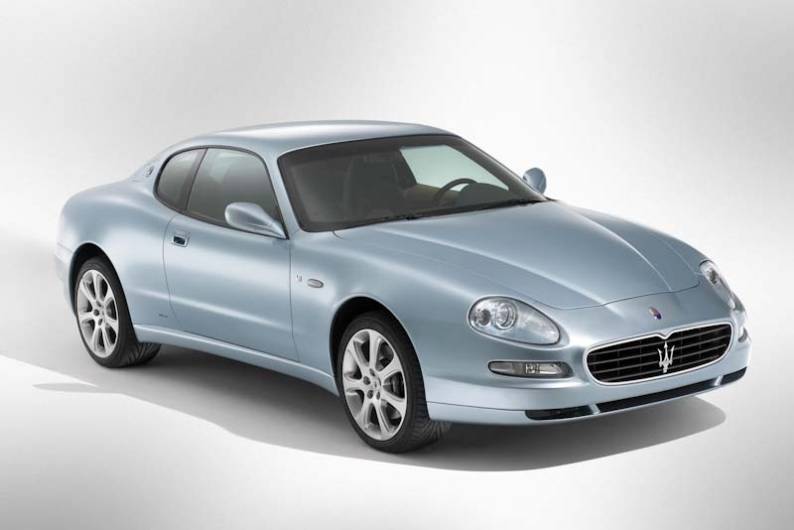
RAC sale – up to 33% off*
• Roadside cover from £5.29 a month†
• We get to most breakdowns in 60 mins or less
• Our patrols fix 4/5 breakdowns on the spot

BY ANDY ENRIGHT
Introduction
Since being acquired by Ferrari, Maserati has had not only a huge injection of cash, but also a hefty boost to build quality. This has helped put cars like the Maserati 4200GT, the successor to the 3200GT, well and truly on the map. Whereas Maseratis were once a real plunge into the unknown, these days buying a new or a used late shape Maserati can be justified on a number of counts. If you're looking for a genuine slice of exotica but don't want to fork out six figures, a lightly used Maserati 4200GT is probably your safest bet.
Models
Models Covered:
(2 dr coupe 4.2 petrol [Coupe, Spyder, Cambiocorsa])
History
1998 was a key date for Maserati. The 3200GT was launched, the first of the truly modern Maserati models, and it was an instant hit. This car was rapidly developed throughout its four year lifespan and it took many by surprise when Maserati, now operating under the auspices of the Prancing Horse of Ferrari, unveiled the 4.2-litre Coupe in 1998. Although it looked superficially similar, the 4200GT was a radically different car. For a start, the last link to the Biturbo era, the twin-turbo 270bhp 3.2-litre engine, had been given the heave-ho in favour of a big, normally aspirated 390bhp 4.2-litre V8 developed by Ferrari and which Maserati got first dibs on.
The silhouette of the Coupe was similar but look a little closer and the changes were manifest. The LED boomerang style lights were replaced by more conventional units and the electronics were a whole lot more sophisticated. Spyder open-topped models and Cambiocorsa semi-automatic options were also offered. The marketers branded fixed and open-topped variants simply as the 'Maserati Coupe' and 'Maserati Spyder'.
What You Get
The casual observer may well note the disappearance of the boomerang LED tail lights that were the trademark stylistic signature of the 3200GT, this car's predecessor. Those who are immersed slightly deeper in the lore of Viale Ciro Menotti will also spot the power bulge in the bonnet that hints at something more purposeful lurking beneath. Don't be deceived by the aesthetic nips and tweaks. The 4200GT has been redesigned from the ground up and in recent revisions, it has gained a new steering box, new shocks, bigger anti-roll bars, the Maserati Stability Programme (MSP), Skyhook suspension and the Navtrak GPS security system.
The truncated Spyder looks slightly buggy-like, with wheels that can appear too big for it - in many ways like a car designer's sketch made metal. The back seats were the first casualty of this transformation, the Spyder being a pure two-seater roadster in the old tradition. The Spyder's hood is something of a disappointment, being an electrically folding fabric item which takes quite some time (28 seconds) to raise and lower - not something you'd expect in such a pricey car, especially with Mercedes' latest SL model showing how the whole roof thing is done. Still, with the hood down, the Spyder looks a beauty and even with it up, the lines look agreeably smooth. Quite enough, in other words, to persuade potential buyers of convertible versions of the Aston Martin DB7, Porsche 911 and Jaguar XKR to schedule another test drive into their Palm Pilots.
What You Pay
Please fill in the form here for an exact up-to-date information.
What to Look For
Although no significant mechanical issues surround the 4200GT, build quality has been an ongoing concern, and those who expect their cars to function with the metronomic efficiency of a Toyota should probably look elsewhere. Nevertheless, Ferrari instigated a rolling programme of improved quality control, and later cars are noticeably 'tighter' in terms of fit and finish than early cars.
If you are giving a 4200GT the once over, make sure that all the electrics are operating, that the wheels, tyres and bodywork are in perfect condition and the interior isn't looking too careworn. The leather trim is hardy, but try to avoid the paler colours that get dirty extremely quickly. The Coupe is very colour sensitive and exterior colours like yellow and black never sell as well as silver and metallic blue. Check for a full service history, and if buying privately pay for an HPI check - it's a wise investment.
Replacement Parts
(approx prices based on 2002 4200GT Coupe) Compared to many exotics, a new clutch assembly is fairly reasonable, retailing at around £480, but front brake pads are pricey at £255 a pair and £280 for a set of rears. A new exhaust system is around £3,600 excluding catalysts and an alternator costs approximately £490.
On the Road
When Ferrari took over stewardship of Maserati halfway through the development cycle for the 3200GT, certain Maserati touchstones rested uneasily amongst the Ferrari top brass, foremost amongst which was the twin turbocharged engine. Plumbed into the 3200GT, this engine had the most electrifying acceleration when the turbochargers were at maximum attack but was frustratingly awkward to pilot through urban traffic. The 4200GT ditches the forced induction in favour of greater capacity and hugely increased sophistication.
Another litre in capacity doesn't in itself explain why this normally aspirated unit generates a full 20bhp more than its twin turbocharged predecessor. With 390bhp on tap, it's devastatingly potent. The use of various weight saving components (like an innovative dry-sump lubrication system and variable inlet timing system) all point to the fact that this is a far more modern engine than the twin-turbo unit used by the old 3200GT. That power translates into some quite stunning performance, 60mph disappearing in 4.7 seconds with 177mph clicking onto the speedometer where conditions allow. The brakes are well up to the task too, with big 330mm discs and Brembo callipers at the front that give genuinely breathtaking powers of retardation.
As with all the best Italian engines, the Maserati's is also something special to look at with crackle-finished aluminium castings sitting atop this Ferrari-designed powerplant. It sounds the part too, with a deep-chested burble that's more muscle car than Maranello. The improvement over the binary 3200GT unit is startling. It's tractable throughout a wide range, pulling cleanly in third from walking pace. Handling is similarly versatile, the 'Skyhook' telemetry system monitoring the movement of wheels and body and transmitting this data to a central unit. This in turn determines the running conditions and adjusts each damper to give maximum comfort and response. In Sport mode, the ride is a good deal firmer than you'd find on, say, a Jaguar XKR or even a Porsche 911 and the traction control system is backed off slightly, letting the enthusiast driver take a few more liberties with all that horsepower. Even if you take too many, the MSP (Maserati Stability Programme) will be on hand to rein the car back in.
Buyers can also choose the Cambiocorsa semi-automatic paddle-shift gearchange borrowed from Ferrari which interfaces with the same six-speed gearbox the manual model uses. If you opt for the manual car, you'll be treated to a gearshift which, in this instance, is traditionally heavy and obstreperous. Pay extra for Cambiocorsa (and Maserati reckon 60% of buyers have) and you'll have an easier time. With four modes of operation (Manual, Automatic, Sport and Snow) it interfaces with the rest of the car's electronic systems to provide a passable level of driver control.
In standard manual mode, the software ensures that you can't engage a gear that will damage the gearbox, will auto-upshift when the car reaches the redline or downshift when the 1200rpm stall point is reached. Should you merely wish to waft around enjoying the ambience, the automatic mode does a passable imitation of a proper torque converter-equipped slushbox but you suspect you're missing the point. It also makes some curious rattling noises on low-speed downshifts. Best to flip it back to manual and enjoy zipping up and down the gears just for the sake of it, relishing the engine's delicious throttle blip as you knock the gearbox down a couple of cogs as you enter your favourite hairpin. Bystanders may attribute the perfect 'heel and toe' downchange to you by the bark from the engine, although the speed of the subsequent upshifts may betray your electronic assistant, especially if you switch to Sport mode.
Overall
There aren't too many viable alternatives to a Porsche 911 but if German efficiency leaves you cold, it's well worthwhile trying the Maserati 4200GT. Its engine is a magnificent thing and there's a genuine sense of occasion when you spot that Trident badge and drop into the hand-finished interior. In terms of ultimate handling ability, the Italian car is geared a little more towards the Gran Turismo end of the scale but it nevertheless likes to be shown a corner. With many of the nagging reliability issues now ironed out, this is one Maserati that can safely be recommended. For the price of a decent Mercedes E Class, here's something that really cuts a dash.





![Mercedes-AMG C 63 [S205] (2015 - 2021) used car review](https://d1ix0byejyn2u7.cloudfront.net/drive/images/made/drive/images/remote/https_d2yv47kjv2gmpz.cloudfront.net/filestore/5/8/9/1_264df880a30da09/696059414da19de6d40c513ec12808c0/1985_59fb65008b3d00a_100_100_70_c1_c_c.jpg)

![Mercedes-AMG GT Coupe [C190] (2015 - 2023) used car review](https://d1ix0byejyn2u7.cloudfront.net/drive/images/made/drive/images/remote/https_d2yv47kjv2gmpz.cloudfront.net/filestore/1/8/9/1_e04c6067f658448/997f9d825809fd8dc1160598f2bff15b/1981_cf8014932bae2d4_100_100_70_c1_c_c.jpg)